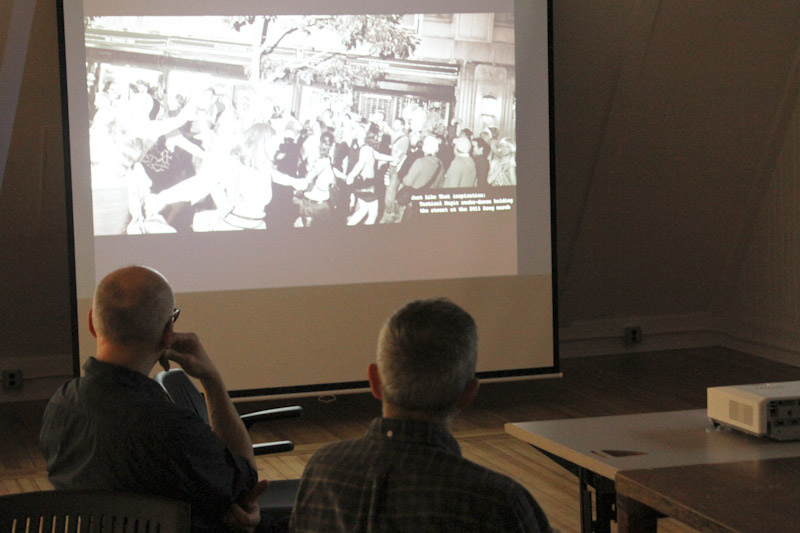Spring 2012 Fellow
Fellow: Daniel Lang/Levitsky
Project: Just Like That
WHEN I MOVE YOU MOVE (just like that)
WHEN YOU MOVE WE MOVE (just like that)
WHEN WE MOVE YOU MOVE (just like that)
WHEN YOU MOVE I MOVE (just like that)
about Just LIke That
Just Like That was a project investigating, participating in, and intervening on the choreography of protest. Stepping away from the fantastic dance-based projects which aim to enliven street actions (Radical Cheerleaders, Pink Bloque, RMO Tactical Spectacle, etc.), Just Like That focused on the front lines. Just Like That proposes that if we don't understand all the things we do with our bodies when we participate in direct action as choreography, we can't understand how to do them well.
When do we link arms? sit? hold hands and spiral-dance?
When do we cluster? form tight lines? lock ourselves in place?
Just Like That aimed to understand and practice highly effective choreography: movement that gets things done concretely, that uses bodies in space to make political analysis visible, that helps participants and observers understand in their bodies the what, why, and how of resistance. We ask: How can we understand and hone these skills, and focus them on the street? How do we go from largely unarticulated, often specialized knowledge to articulate, available knowledge?


Just Like That pursued these questions through militant research based on bodily practice, anchored within the Occupy/Decolonize movement. We sought insight and approaches in the street, and in other high density/high intensity sites: among 'tactical magick' faerie circles; on the punk rock and deep house dance floors where we learned collaborative movement as well as 'defensive dancing' anti-harassment skills. Just Like That held public reportbacks on our research and choreographic tactics in Fall 2012 and Spring 2013. On Thursday, April 18th, 2013, 6:30 pm, at City College of New York, Daniel Lang/Levitsky, Culture Push, and the Digital and Interdisciplinary Art Practice Program at the City College of New York hosted a public presentation and conversation on the findings of Just Like That.
Key Interlocutors/Research Participants (organizations for identification only)
Ariel Speedwagon Federow (Aftselokhes Spectacle Committee)
Emily Forman (x-Miles de Viviendas)
Claire Lebowitz (OWS People's Puppets)
Kevin Buckland (350.org)
Dey Hernańdez (Papel Machete)
Muppet Matt (Beehive Collective)
Alma Shepard-Matsuo (OWS People's Puppets; RMO)
Zachary Wager Scholl (Aftselokhes Spectacle Committee; RMO)
Jason Hicks (Bread & Puppet; Flying Donkey Puppet Theater)
The Rude Mechanical Orchestra's Tactical Spectacle performance squad
Participants in the Aftselokhes Spectacle Committee's 2013 Purim farbrengen
Some Highlights of Research
ABOUT, WHY, AND IN GENERAL:
Filling space in interesting ways as way of asserting control over that space.
Contagious actions
On-the-spot teaching (which is also teaching folks to teach) - spreading moves, signals, etc.
Social acts that are not communicative acts -- this is meaty, gimme more
How the appearance of a prepared unified crowd affects both the group (us) and the police.
Physical organization (repetition, unison, etc.) Can imply/communicate unity of goals, ideological harmony, etc.
Using our organization as a group to disrupt the narratives that the cops may have built around us as protestors.
Disrupting our fight/flight responses during confrontational situations by finding something to do with that energy/adrenaline.
Being busy and sounding reasonable as a way to delegitimize and marginalize hotheads and provocateurs (in part by escalating their provocations)
Working with boredom:
- Working against weaponized boredom - in kettling situations, etc.
- Boredom as part of what makes participating in the physical organizing interesting
SOME WHATS AND HOWS
Snake-dances and Circle-dances
- as ways of moving through space
- as ways of filling space
- as modular structures for unifying a crowd
- with motion between tight and loose connections
- holding hands vs linking arms, etc.
Crystalline structures
- “freeze and touch as many people as you can"
- “form a star with the six people closest to you"
- to fill and solidify space
- to surround a snatch-squad arrest
Super-slow-motion
- as disruptive compliance
- as a way of filling space
- as a way of controlling visibility
Using levels
- falling down / melting / jumping
- high fast / low slow or high slow / low fast
Strategic obliviousness
